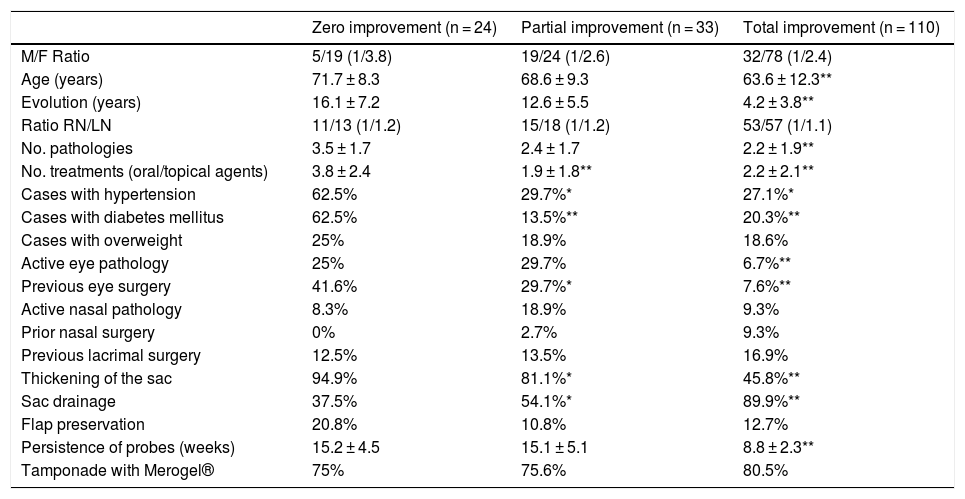Chronic dacryocystitis is the condition secondary to permanent lacrimonasal duct stenosis (LNDS) that generates epiphora and recurrent conjunctivitis. Endoscopic dacryocystorhinostomy (EDCR) is a more natural route than the external route and offers higher success rates than the laser technique. We value this centre's experience in this procedure.
Patients and methodsA retrospective review was carried out in our centre of the medical records of adult patients undergoing EDCR due to LNDS between 1995 and 2019. The minimum follow-up period required after surgery was 6 months.
ResultsOver 297 months, 167 EDCR procedures were performed on 156 patients, with an average age of 65.7 ± 11.6 years and a male/female ratio of 1/1.98. The functional improvement was 86%, with an anatomical success rate of 87%. Lack of clinical improvement statistically significantly correlated with the age of the patient and the time since onset of the LNDS, the presence of concomitant systemic (especially diabetes mellitus) or ophthalmological disease, the intraoperative finding of a thickened tear sac and absence of drainage of the tear sac when marsupialised. Longer-term stent carriers in the rhinostomy had poorer outcomes. There were no postoperative complications of interest.
ConclusionsEDCR is an effective and safe technique, based on stable anatomical references. Failure rate seems to be multifactorial and should be considered in older, multipathological patients, with a long duration of the condition.
La dacriocistitis crónica es la patología secundaria a la estenosis del conducto lacrimonasal (ECLN) permanente, generando epífora y conjuntivitis de repetición. La dacriocistorrinostomía endoscópica (DCRE) supone una vía más natural que la vía externa y ofrece tasas de éxito superiores a la técnica láser. Valoramos la experiencia de este centro en este procedimiento.
Pacientes y métodosSe efectuó una revisión retrospectiva de los registros médicos en pacientes adultos sometidos a DCRE por ECLN entre 1995 y 2019 en nuestro centro. El período de seguimiento mínimo requerido después de la cirugía fue de seis meses.
ResultadosEn 297 meses se efectuaron 167 procedimientos de DCRE sobre 156 pacientes, con una edad media de 65,7 ± 11,6 años y una relación hombre/mujer de 1/1,98. La mejoría funcional fue del 86%, con una tasa de éxito anatómico del 87%. La ausencia de mejoría clínica se correlacionó de forma estadísticamente significativa con la edad del paciente y el tiempo de evolución de la ECLN, la presencia de patología concomitante sistémica (especialmente diabetes mellitus) u oftalmológica, el hallazgo intraoperatorio de un saco lacrimal engrosado y la ausencia de drenaje del mismo al marsupializarlo. Los pacientes con peor respuesta fueron portadores de stents en la rinostomía durante más tiempo. No existieron complicaciones postoperatorias de interés.
ConclusionesLa DCRE es una técnica eficaz y segura, fundamentada en referencias anatómicas estables. La incidencia de fracasos parece multifactorial y debe contemplarse en pacientes añosos, pluripatológicos y con largo tiempo de evolución de la enfermedad.











